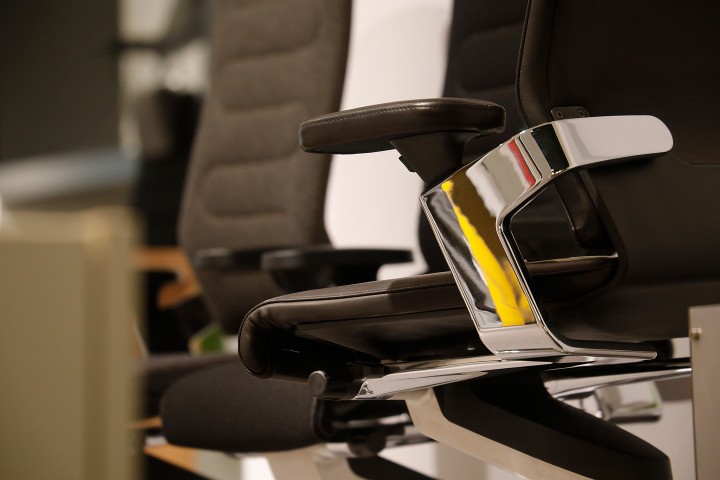The history of the office chair
The Windsor chair
In the middle of the 19th century, the first office workers sat on Windsor chairs, a light wooden chair that was developed in England in the early 18th century and is still produced today. The seat of the chair is slightly adapted to the body shape, the chair legs are turned and the backrest is made of rods. Some Windsor chairs have armrests. This first office chair owes its popularity mainly to its small amount of wood and its simple production method with few tools. The chair gains stability through the diagonally inserted chair legs with three cross connections. The chair got its name from the city of Windsor, from where the chairs were exported across the Thames to London and from there to other countries. The Windsor chair was the beginning of mass production of furniture. It was relatively inexpensive. From 1840 onwards, the first office chairs were available in the United States, which could be moved in different directions by springs.
Development of office furniture through work philosophy
Frederick Winslow Taylor's work philosophy had an impact on the entire 20th century. Taylor spent more than 30 years conducting research in factories to understand the work processes. He published his organizational theories in his paper "Scientific Management". As a result, workers became specialists in precisely defined operations, known as Taylorism. In addition, Taylor recommended that management should give people detailed instructions for their tasks and work processes and strictly monitor their execution. As a result of scientific findings, the requirements for office chairs, desks and workplaces in general changed. In addition, new production processes were introduced, which also had a strong influence on the design. The first chairs were made of iron and steel, the upholstery consisted of fabric cushions filled with horsehair.
The first plastic in the office
Around 1905, Leo Hendrik Baekeland developed bakelite, a thermosetting plastic that could be pressed into any desired shape. Bakelite is heat-resistant and inexpensive. Office chairs were also made from this material.
The cantilever chair - steel furniture
In 1928 Bauhaus designer Marcel Breuer designed his famous cantilever chair as a swivel chair, the seat is mounted on a turnstile. The cantilever chairs themselves were produced by the Thonet company and marked a first milestone in ergonomics - not only for office chairs.
Materials and design after World War II
After the Second World War, new materials found their way into the furniture industry, including materials with which the famous designers Charles & Ray Eames also experimented, fiberglass, aluminum and multi-bonded plywood. In the 1960s, heat-formable plastics (thermoplastics) and the injection moulding process followed. Shapes like the iconic Panton Chair by Verner Panton became possible.
Ergonomic aspects
Since the 1970s, designers have been increasingly concerned about ergonomics. The basis was Henry Dreyfuss' "Measure of Man" from 1960 and "Humanscale" by Niels Diffrient, which also took into account the angles when sitting between the leg and upper body and between reclined and upright positions. Diffrient (1928-2013) inspired other designers to consider the needs of the human body before designing an office chair and to implement everything technically possible. For his work Niels Diffrient was elevated to the status of "Royal Designer for Industry" in 1987.
Topic modern working - ergonomic office chairs, height-adjustable tables
The triumphant advance of the computer since the 1980s gave rise to the ideas of the paperless office and the home office. Even within some companies, mobile working is practiced, with employees taking up their workplaces wherever there is a free space. In addition to the popular executive chair, items that can be changed quickly are therefore also in demand, such as modern, ergonomic office chairs, stools and height-adjustable tables. For some time now, office chairs from renowned designers have also been available with lumbar support, also known as lumbar support, which supports the curvature of the spine in the lumbar region. Other seating concepts, such as the Wilkhahn Stitz, focus on mobilizing the muscular system. By alternating sitting and standing at modern stand-up sitting tables, the spinal column can be additionally relieved. You will find many ergonomic and durable pieces of office furniture in the pro office Shop.
Recycling of office furniture
Well-known companies such as Vitra are also thinking about the recycling of office furniture and are implementing the Cradle to Cradle principle as an approach to a circular economy, if it is feasible. The manufacturer Vitra even offers products that are made directly from recycled material, such as the Tip Ton Re by Edward Barber & Jay Osgerby. The Wiggle Side Chair by Frank Gehry is made directly from cardboard.
Work 4.0
We don't know yet whether we will work lying down from the sofa or outdoors in the future. Some ideas are that working outdoors could reduce electricity consumption and improve the mood. It remains to be seen whether green classrooms in schools and universities and working on roofs or on the lawn of a company will become models of the future - it is certainly an interesting idea.




